The Third International STS Summer School Anthropology of science and contemporary forms of life: Camera Ethnography approach in studying laboratory practices
The Third International STS Summer School Anthropology of Science and Contemporary Forms of Life: Camera Ethnography approach in studying laboratory practices took place in between June 30 – July 7, 2017 at city of Tomsk and Kaibasovo field station at Ob River in Western Siberia, Russia. It was the second one held at the same location in Russia (the first took place in 2015 at Rozhen National Astronomical Observatory, Bulgaria). The organizers were again the Tomsk State University’s Laboratory of Socio-Anthropological Research (LSAR), the Center for Socio-Political Research of Technologies (PAST Center), the Laboratory of Biogeochemical and Remote Methods of Environmental Monitoring, the Center for Excellence "Bio-Clim-Land" and Scientific Research Institute of Biology and Biophysics (SRI BB).
This year the school was dedicated to teaching students to look at the laboratory life of the Kaibasovo field station through the camera ethnography method, one of the most original visual methods in anthropology. Participants were twice as many as in the previous year - 13 people: bachelors and undergraduates from social sciences from Moscow, St. Petersburg, Yekaterinburg, Novosibirsk. Among them were two graduate students - from the Higher School of Economics (Moscow) and the University of Hong Kong (citizen of New Zealand).
According to the tradition, the school began with theoretical lectures and master classes of invited lecturers with subsequent fieldwork on the basis of the Kaibasovo field station. It should be noted that the emphasis on "field" is a feature of the summer STS schools in Tomsk, which makes them unique in Russia.
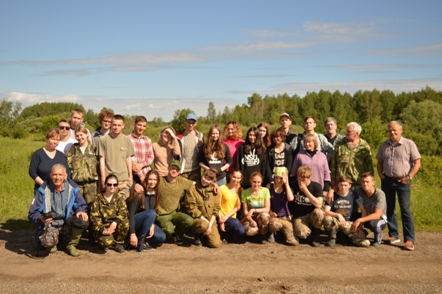 |
| Participants of the Third International STS Summer School “Anthropology of Science and Contemporary Forms of Life”, Kaibasovo Photo by Dmitriy Gureev |
The theoretical framework of the school discussed during the first two days, combined actor-network theory (ANT) as one of the key STS research traditions with the principles of modern anthropology in studying contemporary societies. In this combination, the ethnographic approach of Klaus Amann, Stefan Hirschauer and Karin Knorr-Cetina, as well as the sociology of attachment of Antoine Hennion, play a special role. They allow us to consider scientific and engineering practices not only as an agonistic field of "trials of strength" between people and non-human entities, but also as a hotbed of phenomena of passion, attachment and fortitude. These phenomena manifesting themselves in a delicate and often silent manner, along with their subtle asymmetries, stayed away from the mainstream of the social sciences for a long time, maybe because of the lack of a suitable research methodology.
Ivan Tchalakov, professor at the University of Plovdiv (Bulgaria), opened the school with a lecture on the evolution of the modern laboratories as an object of research in the STS. Andrei Kuznetsov, associate professor at Volgograd University, suggested to follow Bruno Latour and to apply material semiotics to the study of scientific practices. Associate Professor Evgeniya Popova and Dr. Katerina Guba - both at PAST Center and the European University in St. Petersburg - broadened students’ understanding of the laboratory and scientific practice, considering them from an institutional point of view, and as a relationship of power. Graduate student of the Faculty of Social Sciences, Higher School of Economics (Moscow), Kristina Popova presented her experience of visual observation in the laboratory of transcranial magnetic stimulation.
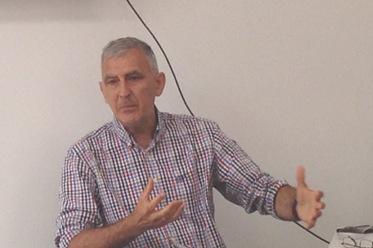 |
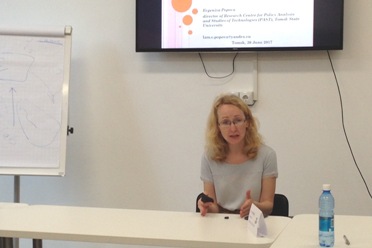 |
| Ivan Tchalakov Photo by Lyubov Torlopova. |
Evgeniya Popova Photo by Lyubov Torlopova. |
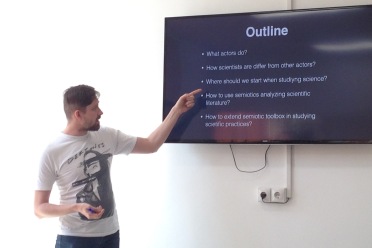 |
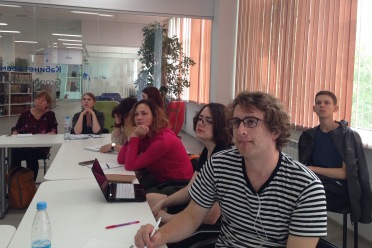 |
| Andrey Kuznetsov Photo by Lyubov Torlopova. |
Participants at the lecture room Photo by Lyubov Torlopova. |
A special focus of the program theoretical part has been the participation of Dr. Bina Elisabeth Mohn (Siegen University and the Center for Camera Ethnography in Berlin) and Dr. Jürgen Streeck (professor at the University of Austin in Texas, USA). Both lecturers are experienced researchers of scientific and everyday practices using visual methods. Jürgen have been for a long time engaged in a micro-ethnographic study of auto-repairing shop in Austin, Texas, with an emphasis on gestures and bodily interactions of his main hero – the technician Hussein who owned the shop. He shared his experience of study of nonverbal communication, which could possibly provide useful insights in the ethnographic study of laboratory practices.
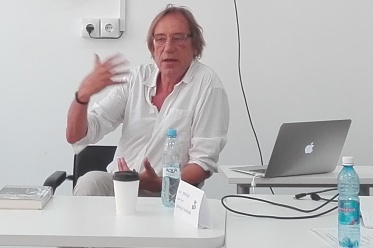 |
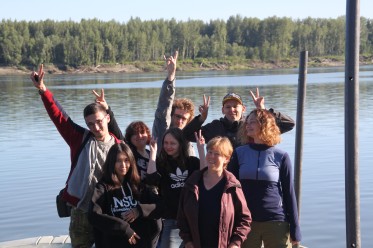 |
| Jurgen Streeck Photo by Irina Popravko |
Bina Mohn together with participants at Kaibasovo Photo by Ilya Lomakin |
As can be seen from the school's theme this year, following the Jürgen Streeck’s lecture, Bina Mohn's seminar laid the ground for the fieldwork that followed. The Camera Ethnography approach, developed by her together with Klaus Amann, is a particularly suitable visual methodology where camera use and film editing are framed as analytic procedures. The generation of "how questions", specific for this ethnographic approach, is directing the iterative process of filmic observations (where each subsequent stage in the field work is enriched by the analysis of the previous cycle of camera observations and their chosen foci). This allows not only to register or record, but also to actively focus on and thereby visualize the delicate and silent inter-corporeal practices of science, technology, and other spheres modern life.
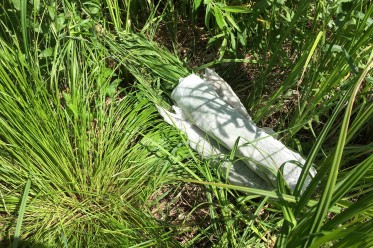 |
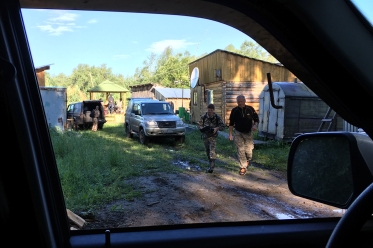 |
Examples of doing camera ethnography (Kaibasovo)
Photo by Bina Mohn
The peculiarity of this summer's summer school was its internationality - in addition to foreign lecturers at the theoretical stage, during the fieldwork the participants met not only with Tomsk biologists, but also with their foreign counterparts from the universities of Lund (Sweden) and Toulouse (France).
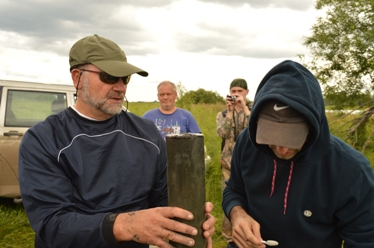 |
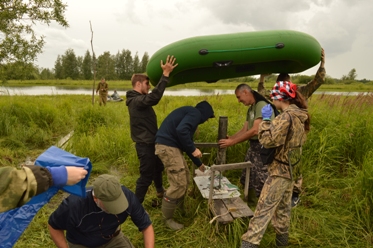 |
Work of French and Russian researchers at Kaibasovo research station
Photo by Dmitriy Gureev.
The director of the Center for Excellence Bio-Clim-Land, the professor of the Biological Institute of the TSU Sergey Kirpotin made an introduction to the large-scale Bio-Clim-Land international research project. He stressed that with the scale of the Ob River the most important are the following biochemical processes taking place in its catchment basin: the dynamics of the oxygen-carbon cycle and the release of methane - all of them are of global importance. It was for the study of these processes that a network of research stations was created within the framework of the Bio-Clim-Land project. Sergei Kirpotin paid special attention to the history of the Institute of Biology and Biophysics, beginning with the days of his first director, Gennady Plekhanov, with a special emphasis on the figure of Yuri Lvov, the founder of the school of integrated landscape ecology (in 2016, this school received the status of the "Presidential Scientific School"). Professor of the Biological Institute of TSU Alexei Rudoy - an experienced researcher of extreme natural phenomena - shared his experience in the context of the research project Bio-Clim-Land. In the following days the participants were also addressed by the fishing agency supervisor of Krivosheinsky district, who in his lecture spoke about the ecological situation on the Ob River and the activities of his department for the protection of species listed in the Red Book.
According to the established rules of fieldwork, the participants were divided into groups of two or three, each of attached to a specific natural sciences’ research group and its leading scientists - botanists (Professor Lyudmila Shepeleva and her students), zoologists (assistant professor Valentina Kuranova), hydrologists (Professor Sergei Vorobyov and his assistants Alexander Ustin and Yakov Seleznev), soil scientists (Assistant professor Larisa Kolesnichenko and her assistants) and microbiologists (graduate student Inna Rozhkova-Timina and Vladislav Mukhortov).
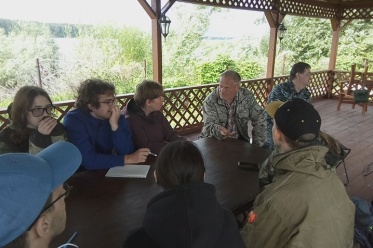 |
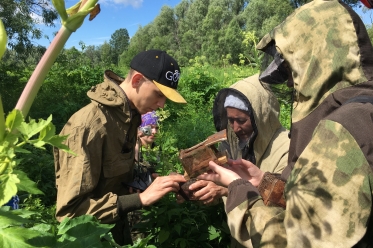 |
| Lecture of Sergei Kiprotin at Kaibasovo research station Photo by Ivan Tchalakov. |
Fieldwork with zoologists Photo by Bina Mohn |
With the arrival of French researchers from the GET laboratory of the Midi-Pyrenees Observatory (Toulouse, France), Stéphane Audry and Cyril Habib Plerre, four of the school attendees closely followed them for two days. Due to the use of new for Russian colleagues technology of collecting bottom sediments in lakes, their work was equally interesting for both anthropologists and biologists. Since the sampling was associated with a parallel accumulation of microbiological and hydrological data gathered by Russian scientists, observing this cooperative endeavor became especially appealing for anthropologists.
 |
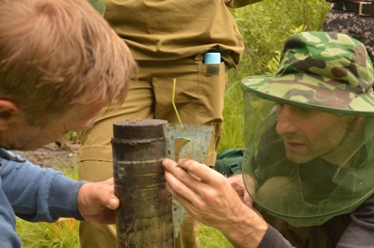 |
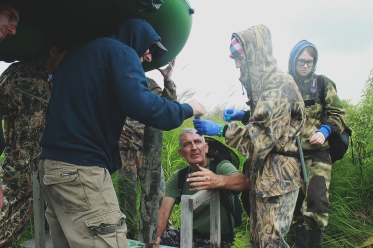 |
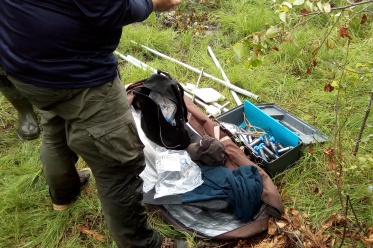 |
Work of French researchers
Photo by Dmitriy Gureev, Olga Makienko, Ivan Tchalakov
Every evening after the end of fields observations Dr. Bina Mohn and Dr. Ivan Tchalakov (as opposed to other lecturers, they were leading fieldwork in Kaibasovo too) discussed with the participants the results of their daily work. Each research group presented selected pieces of their video data, receiving comments and methodological suggestions for the next day of work.
Keeping the focus on applying camera ethnography in studying laboratory practice, Ivan Tchalakov continuously insisted on ‘first things first’ in laboratory studies, i.e. on following the rigorous ANT approach so that students pay enough attention to the stages in the process of translation – the steps and procedures that transform the studied natural objects into data and "scripts" that represent them. It was also possible to identify and record the rules and procedures of this process related to the use of scientific tools - from the simplest to the most complex computerized equipment.
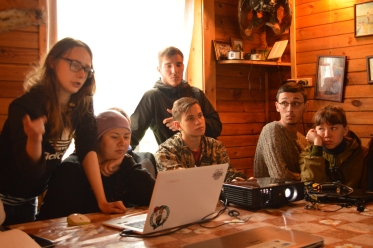 |
 |
| Discussing the results of the fieldwork Photo by Dmitriy Gureev |
Ivan Tchalakov (right) and Stéphane Audry Photo by Bina Mohn |
Yet the main emphasis in fieldwork was made on the development of the initial methodological assumptions and skills in applying the camera ethnography method. Under the guidance of Bina Mohn practically all participants have learned how to develop and use the specific for this method HOW-questions and look for answering them by way of close filmic observations and research practices of ethnographic discovery. It was a great opportunity for the students to work with Bina Mohn personally and share experiences during the fieldwork. Both organizers and students are deeply thankful to her for the effort during the Summer School.
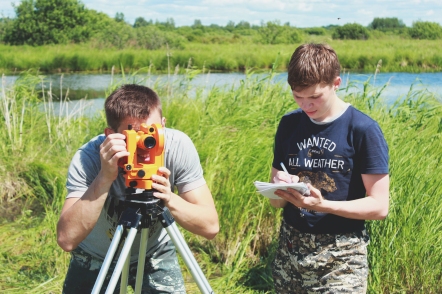 |
| Yakov and Alexander are doing tacheometric survey Photo by Olga Makienko |
The most important results of the fieldwork, revealed during the evening discussions, were the fact that in their enthusiastic work in applying camera ethnography the school participants not only succeed to describe the translation process laboratory practice, but also identified a wide range of other research problems, especially those related with the problem of inter-corporeality, namely:
- How to unveil some specific features of the behavior of experienced researchers in the field?
- What were the mechanisms for transferring expertise from experienced researchers to newcomers?
- The learning processes among young researchers in the course of their independent work with the equipment;
- The phases/stages of discovery (detection of new) during the process of research;
- The problems of attachment and endurances (fortitude) during data collection and analysis;
- The bodily displays of the phenomena of attachment and endurance in laboratory;
- The communication problems within the scientific community and with technical personnel;
- The gender aspects of scientific practice, etc.
We hope that theoretical and fieldwork carried out, in which the participants of the school showed interest and enthusiasm, will give its result in the coming two months when students will work on their research reports. By tradition, the best of them will be published in Russian (or foreign) scientific journals.
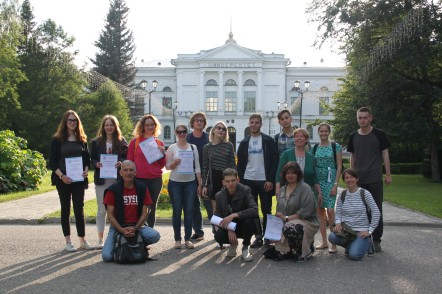 |
| The Third International STS Summer School Anthropology of science and contemporary forms of life Photo Ilya Lomakin |
Irina Popravko & Ivan Tchalakov





 The project "Man in a Changing World. Identity and Social Adaptation: Past and Present" is funded by the Russian Government
The project "Man in a Changing World. Identity and Social Adaptation: Past and Present" is funded by the Russian Government 